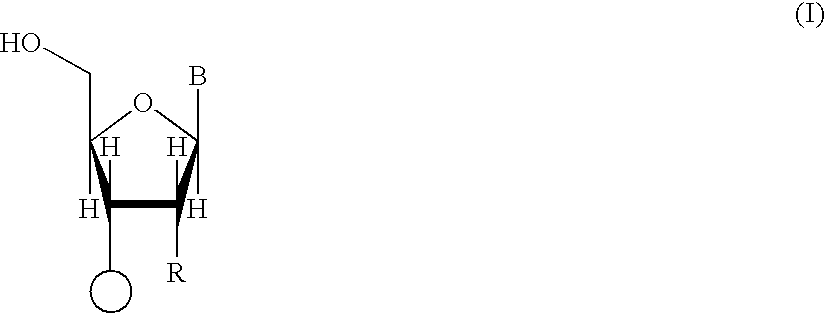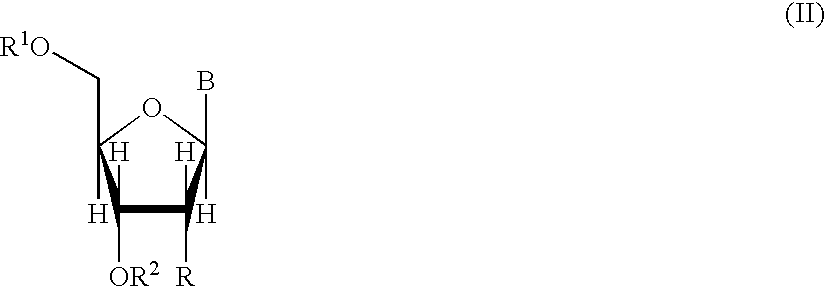Synthesis of polynucleotides using combined oxidation/deprotection chemistry
a polynucleotide and oxidation technology, applied in the field of chemical synthesis of polynucleotides, can solve the problems of reducing the efficiency of coupling yields, and oxidation requiring longer times and harsher reagents, and reducing the efficiency of phosphoramidite synthesis
- Summary
- Abstract
- Description
- Claims
- Application Information
AI Technical Summary
Benefits of technology
Problems solved by technology
Method used
Image
Examples
example i
[0088]On an ABI 394 synthesizer, the deblocking solution (3% TCA in dichloromethane) is removed and replaced with the modified Solution I or II below, and a 1 μmole cycle is modified. After the wash following the capping step, the oxidation step is deleted. The next washes are also removed. After the delivery of dichloromethane (bottle#19), the solution in position #14 is delivered during 30 seconds. Then a 20 seconds wait is used, then the column is washed with acetonitrile (#18).
[0089]All other reagents are conventional. After synthesis on a 1 μmole CPG (Controlled Porous Glass) column, the DNA material is recovered in a 2 ml solution of ammonia / methylamine (1:1) at room temperature during 2 hours. 50 μl of this solution is evaporated with a speedvac concentrator and resuspended in water. The solution is injected in an Agilent HPLC using an ion exchange column from Dionex. Analysis of the peaks gives an estimated cycle yield as indicated below. No difference was observed between c...
example ii
[0094]On a functionalized glass support, using a synthesizer such as in FIG. 4, the deblocking solution is replaced with a single deblocking, oxidizing Solution III according to the present invention. The regular oxidation solution is removed from the synthesizer. There is no dichloromethane wash before the deblocking-oxidation step.
[0095]A typical cycle would be:[0096]Coupling[0097]Capping[0098]Wash with acetonitrile[0099]Oxidation / Deprotection[0100]Wash
Delivery and wait over the surface total 20 to 30 seconds, then the solution is quickly removed from the surface. After total synthesis of one sequence over the entire surface, the slide is dipped in a solution of ammonia / methylamine (1:1) at room temperature during 2 hours. The solution is recovered and evaporated with a speedvac concentrator. Then it is resuspended in water and injected in an HPLC. The results are analyzed as previously explained.
[0101]Solution III: 50 grams of trichloroacetic acid and 2 grams of iodine are added ...
example iii
Concurrent Deprotection and Internucleotide Bond Oxidation
(A) Oligonucleotide Synthesis on Controlled Pore Glass:
[0105]Oligonucleotides are synthesized on CPG using an automated DNA synthesizer (ABI model 380A). The synthesis cycle used for 5′-DMT protected nucleoside phosphoramidites (Cycle 1) is shown in Table 3. This cycle is initially modified for the use of a combined oxidation / deprotection protocol simply by substituting the alternative combined oxidation / deprotection reagent mixtures for the 3% TCA solution (Step 8, Table 3) and varying the exposure times. For the synthesis of longer sequences using nucleoside phosphoramidites having 5′-non-carbonate protecting groups, it is necessary to separate the combined oxidation / deprotection reagent mixture into a two-component system (Table 2), where the two components are preferably quickly mixed together shortly before use of the combined oxidation / deprotection reagent mixture. The separation of the combined oxidation / deprotection r...
PUM
| Property | Measurement | Unit |
|---|---|---|
| pKa | aaaaa | aaaaa |
| temperature | aaaaa | aaaaa |
| total volume | aaaaa | aaaaa |
Abstract
Description
Claims
Application Information
 Login to View More
Login to View More - R&D
- Intellectual Property
- Life Sciences
- Materials
- Tech Scout
- Unparalleled Data Quality
- Higher Quality Content
- 60% Fewer Hallucinations
Browse by: Latest US Patents, China's latest patents, Technical Efficacy Thesaurus, Application Domain, Technology Topic, Popular Technical Reports.
© 2025 PatSnap. All rights reserved.Legal|Privacy policy|Modern Slavery Act Transparency Statement|Sitemap|About US| Contact US: help@patsnap.com



